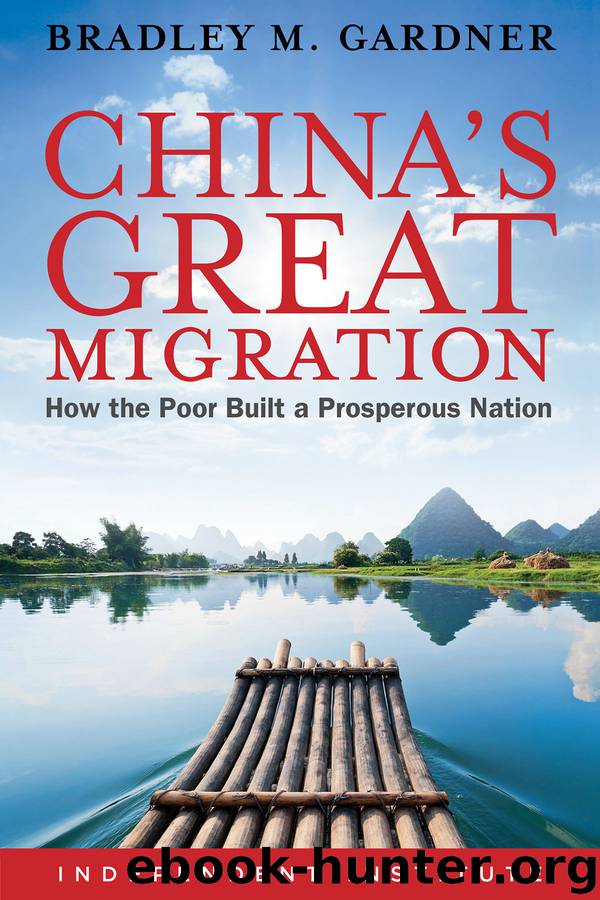China's Great Migration by Bradley Gardner

Author:Bradley Gardner
Language: eng
Format: epub
Tags: -
Publisher: Independent Institute
Published: 2017-02-10T05:00:00+00:00
The Future of the Hukou
China has shown no sign of being interested in ending its hukou system. Instead, it has compromised, expanding access to local hukou coverage and expanding the central government’s role in providing social services.
In the next decade, China is likely to unify the rural and urban hukou system into a single place hukou that specifies which region is responsible for providing a person with social services rather than specifying what social services an individual is entitled to.57 This is certainly better than the system that China currently has in place, but it continues to be a system that values a stable labor market rather than a dynamic one. It’s a system that rewards people for staying at home rather than lowering barriers for people who have the courage to migrate. China’s migration policies are moving in the direction of the European Union, where they should be moving in the direction of the United States.
China has several reforms that it needs to enact over the next decade if it is going to become a country that fully supports migration and urbanization. First, it needs to bring the pension system and the healthcare system under the central budget, while more strictly enforcing school enrollment for migrant children. If it does this, the hukou will be little more than an identity card, just like the cards people are forced to carry in many other countries. The pension system and the healthcare system should be made more market driven in order to loosen the burden on government budgets and reduce distortions. The government should end the nearly bankrupt PAYGO portion of the pension and focus the healthcare system on providing basic insurance for all and transferring funds that go to hospitals on a per-procedure basis to subsidize consumer choices on long-term care provision.
HEBEI IRON & STEEL
Hebei Iron & Steel is the largest steel producer in China and the third largest steel producer in the world. It was formed in 2008 from the merger of three SOEs: Tangshan Iron & Steel, Handan Iron & Steel, and Chengde Xinxin Vanadium & Titanium.58 In 2010, it would forcibly acquire shares in twelve regional private steelmakers, under the agreement that the SOE would share its distribution network and technology in return from the right to negotiate with foreign iron-ore suppliers for the entire group.59
These mergers were part of a broader nationalization of China’s steel industry that had been ongoing since 2007. Government-owned steel mills had been struggling with the rising cost of iron-ore due to high steel demand from the country’s real estate sector. Private sector steel mills had consistently been willing to pay a higher price in negotiations with foreign mining groups, often going behind the back of government negotiators. “Consolidation” gave the country a unified voice to negotiate as well as a means to maintain SOE profit as the real estate sector slowed down. The government aimed to bring 60 percent of the sector under the ten largest companies by 2015, whether the acquired companies liked it or not.
Download
This site does not store any files on its server. We only index and link to content provided by other sites. Please contact the content providers to delete copyright contents if any and email us, we'll remove relevant links or contents immediately.
| Anthropology | Archaeology |
| Philosophy | Politics & Government |
| Social Sciences | Sociology |
| Women's Studies |
Cecilia; Or, Memoirs of an Heiress — Volume 1 by Fanny Burney(32402)
Cecilia; Or, Memoirs of an Heiress — Volume 3 by Fanny Burney(31796)
Cecilia; Or, Memoirs of an Heiress — Volume 2 by Fanny Burney(31769)
The Great Music City by Andrea Baker(31237)
We're Going to Need More Wine by Gabrielle Union(18935)
All the Missing Girls by Megan Miranda(15461)
Pimp by Iceberg Slim(14286)
Bombshells: Glamour Girls of a Lifetime by Sullivan Steve(13946)
Talking to Strangers by Malcolm Gladwell(13170)
Norse Mythology by Gaiman Neil(13160)
Fifty Shades Freed by E L James(13140)
For the Love of Europe by Rick Steves(12539)
Crazy Rich Asians by Kevin Kwan(9144)
Mindhunter: Inside the FBI's Elite Serial Crime Unit by John E. Douglas & Mark Olshaker(9142)
The Lost Art of Listening by Michael P. Nichols(7378)
Enlightenment Now: The Case for Reason, Science, Humanism, and Progress by Steven Pinker(7134)
The Four Agreements by Don Miguel Ruiz(6577)
Bad Blood by John Carreyrou(6512)
Weapons of Math Destruction by Cathy O'Neil(6108)
